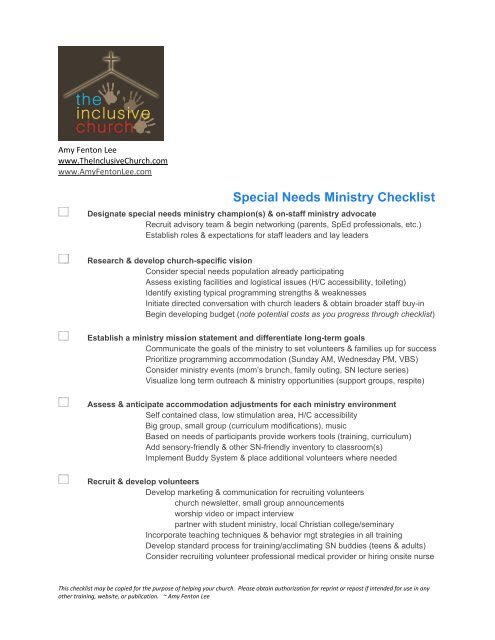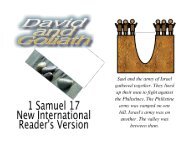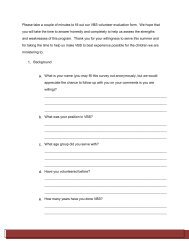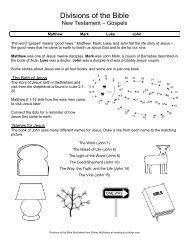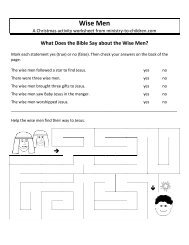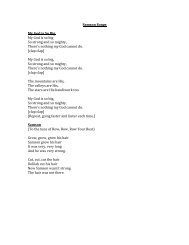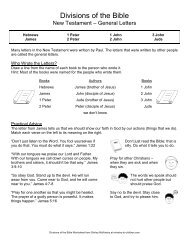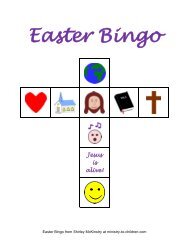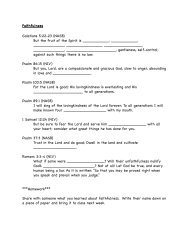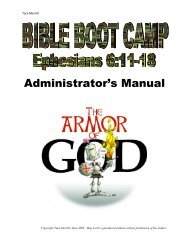Special Needs Ministry Checklist - Ministry-To-Children
Special Needs Ministry Checklist - Ministry-To-Children
Special Needs Ministry Checklist - Ministry-To-Children
Create successful ePaper yourself
Turn your PDF publications into a flip-book with our unique Google optimized e-Paper software.
Amy Fenton Leewww.TheInclusiveChurch.comwww.AmyFentonLee.com<strong>Special</strong> <strong>Needs</strong> <strong>Ministry</strong> <strong>Checklist</strong>Designate special needs ministry champion(s) & on-staff ministry advocateRecruit advisory team & begin networking (parents, SpEd professionals, etc.)Establish roles & expectations for staff leaders and lay leadersResearch & develop church-specific visionConsider special needs population already participatingAssess existing facilities and logistical issues (H/C accessibility, toileting)Identify existing typical programming strengths & weaknessesInitiate directed conversation with church leaders & obtain broader staff buy-inBegin developing budget (note potential costs as you progress through checklist)Establish a ministry mission statement and differentiate long-term goalsCommunicate the goals of the ministry to set volunteers & families up for successPrioritize programming accommodation (Sunday AM, Wednesday PM, VBS)Consider ministry events (mom’s brunch, family outing, SN lecture series)Visualize long term outreach & ministry opportunities (support groups, respite)Assess & anticipate accommodation adjustments for each ministry environmentSelf contained class, low stimulation area, H/C accessibilityBig group, small group (curriculum modifications), musicBased on needs of participants provide workers tools (training, curriculum)Add sensory-friendly & other SN-friendly inventory to classroom(s)Implement Buddy System & place additional volunteers where neededRecruit & develop volunteersDevelop marketing & communication for recruiting volunteerschurch newsletter, small group announcementsworship video or impact interviewpartner with student ministry, local Christian college/seminaryIncorporate teaching techniques & behavior mgt strategies in all trainingDevelop standard process for training/acclimating SN buddies (teens & adults)Consider recruiting volunteer professional medical provider or hiring onsite nurseThis checklist may be copied for the purpose of helping your church. Please obtain authorization for reprint or repost if intended for use in anyother training, website, or publication. ~ Amy Fenton Lee
Establish formal SN ministry policies & procedures, align with existing kidmin handbookConsult church insurance carrier and/or church attorneyRe-assess safety & emergency response across all kidmin with SN in mindDevelop behavior driven P&P and provide guidance for parent partnershipsCreate standard questionnaire and other ministry communication piecesSet up a process for in-take & updates for each participant & familyCreate a culture of acceptanceCreate a host team training event – for sample outline, see:http://theinclusivechurch.wordpress.com/2011/01/19/special-needs-training-for-church-greeters/Provide volunteer & support opportunities for ministry other than just childcareGive disability visibility in church events, during worshipCreate Facebook page, website for the ministryPhoneEmergency ContactsBathroom accessPosted RulesVisual ScheduleCurriculumMusicSensory <strong>To</strong>ysCause & Effect <strong>To</strong>ysGuide RopeSand TimerTri-write crayonsPainters tapeBean bag chairsSmall tentRocking ChairTherabandsSelf-Contained Classroom InventoryLand lines, working cell phones and/or walkie-talkiesPosted laminated sheet with emergency protocol and proceduresFamily bathroom that enables parents to toilet children (ideal); shower a bonus5 – 10 behavior guidelines w/ pictures to aid visual communicatorsPrepare children for transitions and make them part of the “change”Adapt and enhance existing curriculum or purchase new/additional curriculumMusic may be used to encourage movement & reinforce Bible teaching/Scripture<strong>Children</strong> may manipulate toys during Bible lesson or use as a calming toolUse as a calming tool or as a way to engage/distract a child during transitionsHelps wanderers travel between environmentsProvides personal countdown for children who require warning/remindersAids children with fine motor deficits with coloring activitiesDefines personal space on activity tables or on floor, denotes “line-up” spotProvides soothing and relaxing seat & recharge spaceDelineates recharge or quiet space & removes visual distractionMay fulfill a child’s need for movement or rocking motionFulfills child’s need for exertion or pressure when wrapped around legs of chairsRequirement of a completed participant intake form and annual profile update<strong>To</strong>ileting / DiaperingAdministering MedicationSnacks / Allergies / Peanut-free environment(s)Behavior guidelinesSteps for responding to behavior challenges & related parent partnership/communicationProcess for receiving and addressing parent or volunteer concernsResponse to a medical emergency; seizure recognition & responseParticipant/family privacy & confidentialityVolunteer roles & responsibilities; required vs. optional trainingParent partnership (parents onsite during church care, participation in volunteer rotation)<strong>Ministry</strong> PoliciesThis checklist may be copied for the purpose of helping your church. Please obtain authorization for reprint or repost if intended for use in anyother training, website, or publication. ~ Amy Fenton Lee


